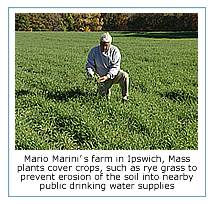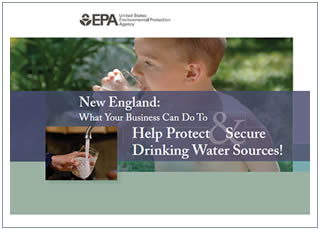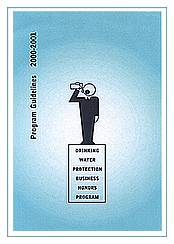EPA New England's Water Supplier-Business Partnership Program
You will need Adobe Reader to view some of the files on this page. See EPA's PDF page to learn more about PDF, and for a link to the free Acrobat Reader.

The EPA New England's Water Supplier-Business Partnership Program encourages businesses to partner with their local water suppliers to prevent contamination of drinking water sources. Through the Source Water Assessment Program, New England states have begun evaluating the susceptibility of public drinking water sources to contaminants. Because businesses, both large and small, will be mentioned in the assessments as potential contributors of pollution, now is a critical time to encourage businesses to voluntarily partner with their local water suppliers to prevent contamination of drinking water sources.
EPA-New England Water Works Association Business Honors Program
Since
1996, EPA's New England Office has worked with the New
England Water Works Association (NEWWA), a section of
the American Water Works Association, to recognize extra
efforts by New England businesses who protect our valuable
drinking water supplies. Through the program, EPA has
honored over thirty businesses which have actively worked
to protect the quality of their local drinking water
sources through improving their processes and land practices,
assisting with local education and helping to protect
critical lands from development. Examples of past honorees
have included a golf course, retail stores, farms, manufacturers,
real estate developer, hotel, and telecommunications
company.
Brochure,
"What Your Business Can Do to Help Protect & Secure Drinking Water Sources!" (PDF) (20 pp, 750 K)
This brochure is written for businesses and explains
the Source Water Assessment Program and how it may relate
to businesses. Common sense tips for minimizing negative
drinking water impacts from business activities is included.

Business Source Protection Video
EPA's New England Office partnered with the New England
Water Works Association, state source water protection
managers, businesses and water suppliers to develop
a video highlighting regional business efforts in source
water protection. The video is available by contacting
Ted Lavery at
EPA's New England office. It includes case studies on
different practices that can be carried out to lessen
impacts to drinking water supplies, including: storm
water treatment, land conservation, pest reduction management,
and pollution prevention.
Best Management Practices
for Drinking Water Protection
EPA has published a series of bulletins on
best management practices (BMP) measures for activities
that are likely to impact the sources of water used
as drinking water. These bulletins are also used in
conjunction with a source
water protection training course.
Bulletins address: stormwater runoff, septic systems,
above and underground storage tanks, vehicle washing,
managing small quantity chemical use to prevent contamination
of drinking water, pet and wildlife waste, agricultural
fertilizer, turfgrass and garden fertilizer application,
large-scale and small-scale application of pesticides,
and sanitary sewer overflows and combined sewer overflows.
Business Source Protection Workbook
This workbook includes case studies, best management
practices and self-audit modules for agriculture, land
development and construction, automotive repair shops,
light industry, and consumer products businesses. The
workbook will be distributed to business associations,
public water suppliers and interested individual businesses
through mailings and presentations at business association
meetings.
Download the workbook
- Table of Contents (PDF) (2 pp, 63 K)
- Chapter 1 (PDF) (6 pp, 38 K)
- Chapter 2 (PDF) (3 pp, 49 K)
- Chapter 3 (PDF) (36 pp, 1.8 MB)
- Chapter 4 (PDF) (14 pp, 1.2 MB)
- Chapter 5 (PDF) (14 pp, 168 K)
- Chapter 6 (PDF) (22 pp, 89 K)
- Chapter 7 (PDF) (6 pp, 33 K)
A hardcopy of the workbook is available by contacting Ted Lavery (Lavery.Ted@epa.gov or (617) 918-1683) at EPA's New England office.

